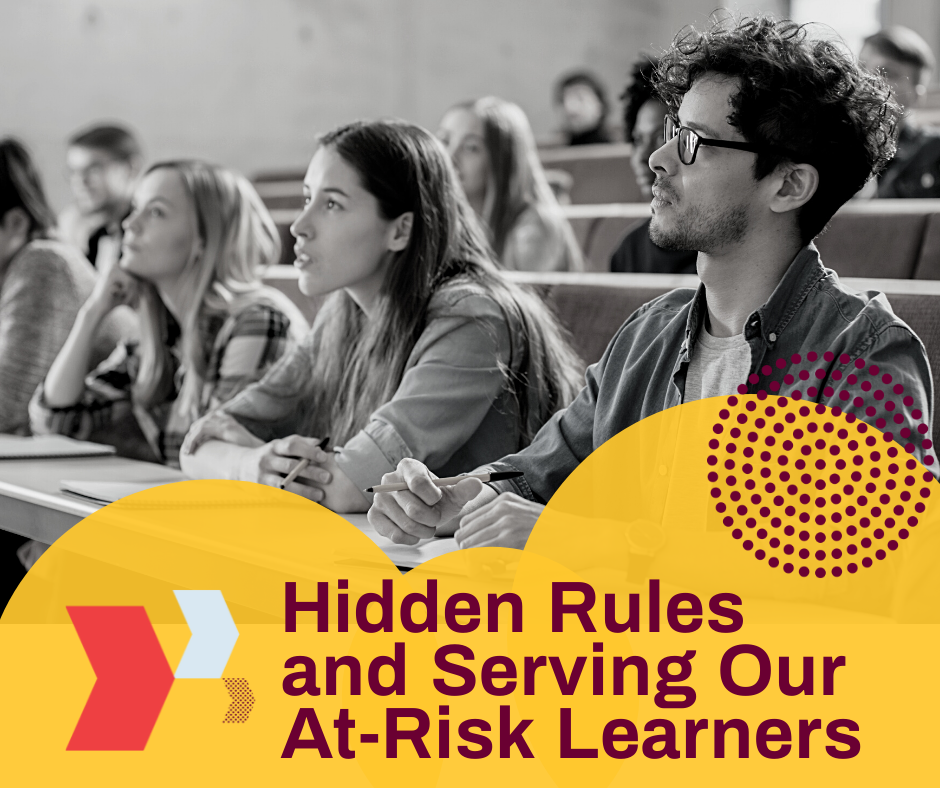In their book, Understanding and Engaging Under-Resourced College Students, Becker, Krodel, and Tucker (2009) remind us that hidden rules “exist in many aspects of life. They are the unspoken understanding that cues the members of any particular group concerning expectations and behaviors….” (p. 28). They also say, “most students, instructors, and staff know only the hidden rules of their own economic class… …[which] restricts the array of choices and responses available, even possible, in a variety of situations” (pp. 28-29). As educators, Becker et al.’s (2009) perspective queries begs how well we know our students and challenges us to eliminate these “hidden rules” that put our students at a disadvantage.
Over the past year, CMU’s Office of Academic Planning & Analysis reports a 20% increase in the percentage of minority and underrepresented students on campus (from 0.8% in fall 2019 to 20.6% in fall 2020). Of these students, 2,480 are undergraduates, 263 are graduate students, and 429 are international students. As CMU’s student population continues to evolve, implementing practices to recognize hidden rules, readily identify and meet diverse student needs, and provide effective support for at-risk learners (as early into their degree as possible) is key.
Hughes Vincent Tinto, a Distinguished Professor at Syracuse University and noted theorist in the field of higher education, said that the primary determinant in whether a student remains enrolled in college is the extent to which he or she is academically and socially integrated into the institution (as cited by Sorcinelli, 2007). This is where exposing students to those “hidden rules” is vital to helping under-resourced, marginalized, and first-generation learners navigate more confidently. It is through equitable, frequent, communication and fostering community, that building trust and connections with all our learners can be achieved. Want to learn more? For more information on identifying at-risk learners, consider this short video, “Do You Know Who I Am? Identifying & Supporting Academically Under-Prepared students.”)
References
Academic Planning & Analysis. (2020). On-campus student profile: Fall 2020. Central Michigan University. https://www.cmich.edu/office_provost/academic_administration/APA/Reports/Documents/Fall%20Student%20Enrollment%20Profiles/On_campus/on_campus_student_fall_profile_2020.pdf
Becker, K.A., Krodel, K.M. & Tucker, B.H. (2009). Understanding and engaging the under-resourced college students: A fresh look at economic class and its influence on teaching and learning in higher education. Highland, TX: Aha! Process, Inc.
Sorcinelli, M.D. (2007). Faculty development: The challenge going forward. The Association of American Colleges & Universities, 9(4). https://www.aacu.org/publications-research/periodicals/faculty-development-challenge-going-forward


So what are the hidden cues we should know?
Great question Anja! To me, the “hidden rules” broadly represent what one group knows (even if they don’t know they know it) but another group does not.
Consider the background knowledge and experience that first-generation college students would not have compared to students coming from homes where one or both parents have university level academic experiences. The disparity, or more specifically, the gaps in the knowledge/experience between the two groups, represent/are the hidden rules: some groups of students recognize and know how to navigate them, but many do not.
Stef speaks to this a bit in the video linked above (Identifying & Supporting Academically Under-Prepared Students). I find the list of characteristics of under-resourced/under-prepared students to be the most telling in terms of what to look for, and targeting these in our course planning and communications, a great place to start. For example, talking with students about their learning and sharing support resources geared to help students recognize gaps in their knowledge and tools to help them develop effective study skills/habits directly connect to several items on that list (see the list at ~1:16 the video, and at around 2:12, Stef even talks about what these look like across different instructional modalities, so hopefully recognizing them in upcoming semesters is a little easier!). Stef also covers communication as a tool that can be used to address these hidden rules and support our students.
Does that help?